Construction Project: Sustainable Building Materials and Techniques
VerifiedAdded on 2022/11/13
|24
|5694
|55
Project
AI Summary
This project delves into the critical examination of sustainable building materials and construction practices, focusing on the imperative of waste reduction and the mitigation of environmental impact within the construction industry. The research meticulously explores various facets, including the evaluation of current construction methods and their ecological consequences, the identification of sustainable building materials, and the analysis of construction waste management techniques. The project also covers the benefits of prefabrication, the selection of eco-friendly materials, lean manufacturing principles, and effective site management strategies. The project aims to provide a comprehensive overview of how the construction industry can minimize its environmental footprint through the adoption of innovative materials, efficient processes, and sustainable practices. The study also addresses the obstacles that managers face in implementing sustainable practices, offering solutions for achieving minimal environmental impact.

1
MAJOR PROJECT IN CONSTRUCTION
By Name
Course
Instructor
Institution
Location
Date
MAJOR PROJECT IN CONSTRUCTION
By Name
Course
Instructor
Institution
Location
Date
Paraphrase This Document
Need a fresh take? Get an instant paraphrase of this document with our AI Paraphraser

2
Executive summary
Buildings normally consume a very high amount of energy and at the same time
generates a huge amount of wastes. The construction methods which are currently
employed in the construction industry tie us into the future patterns of energy and
resources use, waste emission and the environmental damage. When our houses are poorly
designed hey leave a lasting legacy for the coming generations which extends adverse
economic, environmental and social effects through their life cycle (Dhir, 2018, p. 782).
Usually there are many definitions of sustainable buildings in regards to the economic,
social and environmental issues which are commonly referred to as the ‘triple bottom line’;
social in terms of adding quality to the quality of life for the people, economic in terms of
improving wealth and environmental in terms of reducing the effects the building has on
the natural environment. Nevertheless, the ‘triple bottom line' of the sustainability is usually
open-ended and the ecological aspiration greatly vary , more recently focusing on the
aspects which relate to water conservation, transport, and biodiversity in general. A current
significant focus is being placed on the environmental and energy performance of the
building, with certain main aims which involve the reduction of the associated carbon
emission and energy costs. Recognizing and improving many sustainable building materials
and construction practices which can help in minimizing wastes and the ones which are
environmental friendly is identified as the significant aspect of the sustainable building design
(Bryan, 2017, p. 174).
All the sustainable buildings must be resilient to climate change and at the same be
adaptable , durable and flexible in order to increase the life-span of the building. This ‘cradle to
Cradle' approach refers to the building which is designed to be deconstructed and where the
Executive summary
Buildings normally consume a very high amount of energy and at the same time
generates a huge amount of wastes. The construction methods which are currently
employed in the construction industry tie us into the future patterns of energy and
resources use, waste emission and the environmental damage. When our houses are poorly
designed hey leave a lasting legacy for the coming generations which extends adverse
economic, environmental and social effects through their life cycle (Dhir, 2018, p. 782).
Usually there are many definitions of sustainable buildings in regards to the economic,
social and environmental issues which are commonly referred to as the ‘triple bottom line’;
social in terms of adding quality to the quality of life for the people, economic in terms of
improving wealth and environmental in terms of reducing the effects the building has on
the natural environment. Nevertheless, the ‘triple bottom line' of the sustainability is usually
open-ended and the ecological aspiration greatly vary , more recently focusing on the
aspects which relate to water conservation, transport, and biodiversity in general. A current
significant focus is being placed on the environmental and energy performance of the
building, with certain main aims which involve the reduction of the associated carbon
emission and energy costs. Recognizing and improving many sustainable building materials
and construction practices which can help in minimizing wastes and the ones which are
environmental friendly is identified as the significant aspect of the sustainable building design
(Bryan, 2017, p. 174).
All the sustainable buildings must be resilient to climate change and at the same be
adaptable , durable and flexible in order to increase the life-span of the building. This ‘cradle to
Cradle' approach refers to the building which is designed to be deconstructed and where the
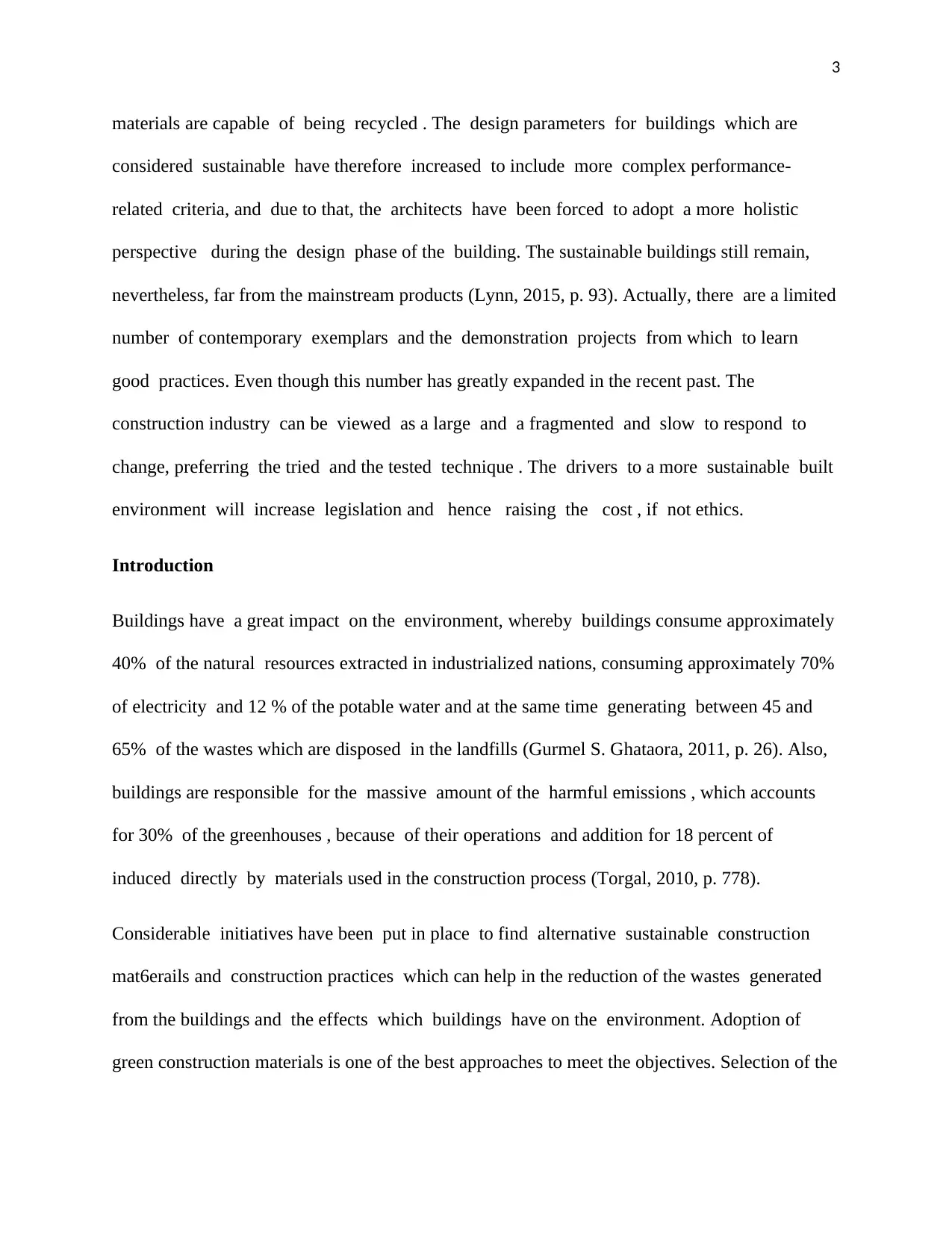
3
materials are capable of being recycled . The design parameters for buildings which are
considered sustainable have therefore increased to include more complex performance-
related criteria, and due to that, the architects have been forced to adopt a more holistic
perspective during the design phase of the building. The sustainable buildings still remain,
nevertheless, far from the mainstream products (Lynn, 2015, p. 93). Actually, there are a limited
number of contemporary exemplars and the demonstration projects from which to learn
good practices. Even though this number has greatly expanded in the recent past. The
construction industry can be viewed as a large and a fragmented and slow to respond to
change, preferring the tried and the tested technique . The drivers to a more sustainable built
environment will increase legislation and hence raising the cost , if not ethics.
Introduction
Buildings have a great impact on the environment, whereby buildings consume approximately
40% of the natural resources extracted in industrialized nations, consuming approximately 70%
of electricity and 12 % of the potable water and at the same time generating between 45 and
65% of the wastes which are disposed in the landfills (Gurmel S. Ghataora, 2011, p. 26). Also,
buildings are responsible for the massive amount of the harmful emissions , which accounts
for 30% of the greenhouses , because of their operations and addition for 18 percent of
induced directly by materials used in the construction process (Torgal, 2010, p. 778).
Considerable initiatives have been put in place to find alternative sustainable construction
mat6erails and construction practices which can help in the reduction of the wastes generated
from the buildings and the effects which buildings have on the environment. Adoption of
green construction materials is one of the best approaches to meet the objectives. Selection of the
materials are capable of being recycled . The design parameters for buildings which are
considered sustainable have therefore increased to include more complex performance-
related criteria, and due to that, the architects have been forced to adopt a more holistic
perspective during the design phase of the building. The sustainable buildings still remain,
nevertheless, far from the mainstream products (Lynn, 2015, p. 93). Actually, there are a limited
number of contemporary exemplars and the demonstration projects from which to learn
good practices. Even though this number has greatly expanded in the recent past. The
construction industry can be viewed as a large and a fragmented and slow to respond to
change, preferring the tried and the tested technique . The drivers to a more sustainable built
environment will increase legislation and hence raising the cost , if not ethics.
Introduction
Buildings have a great impact on the environment, whereby buildings consume approximately
40% of the natural resources extracted in industrialized nations, consuming approximately 70%
of electricity and 12 % of the potable water and at the same time generating between 45 and
65% of the wastes which are disposed in the landfills (Gurmel S. Ghataora, 2011, p. 26). Also,
buildings are responsible for the massive amount of the harmful emissions , which accounts
for 30% of the greenhouses , because of their operations and addition for 18 percent of
induced directly by materials used in the construction process (Torgal, 2010, p. 778).
Considerable initiatives have been put in place to find alternative sustainable construction
mat6erails and construction practices which can help in the reduction of the wastes generated
from the buildings and the effects which buildings have on the environment. Adoption of
green construction materials is one of the best approaches to meet the objectives. Selection of the
⊘ This is a preview!⊘
Do you want full access?
Subscribe today to unlock all pages.

Trusted by 1+ million students worldwide
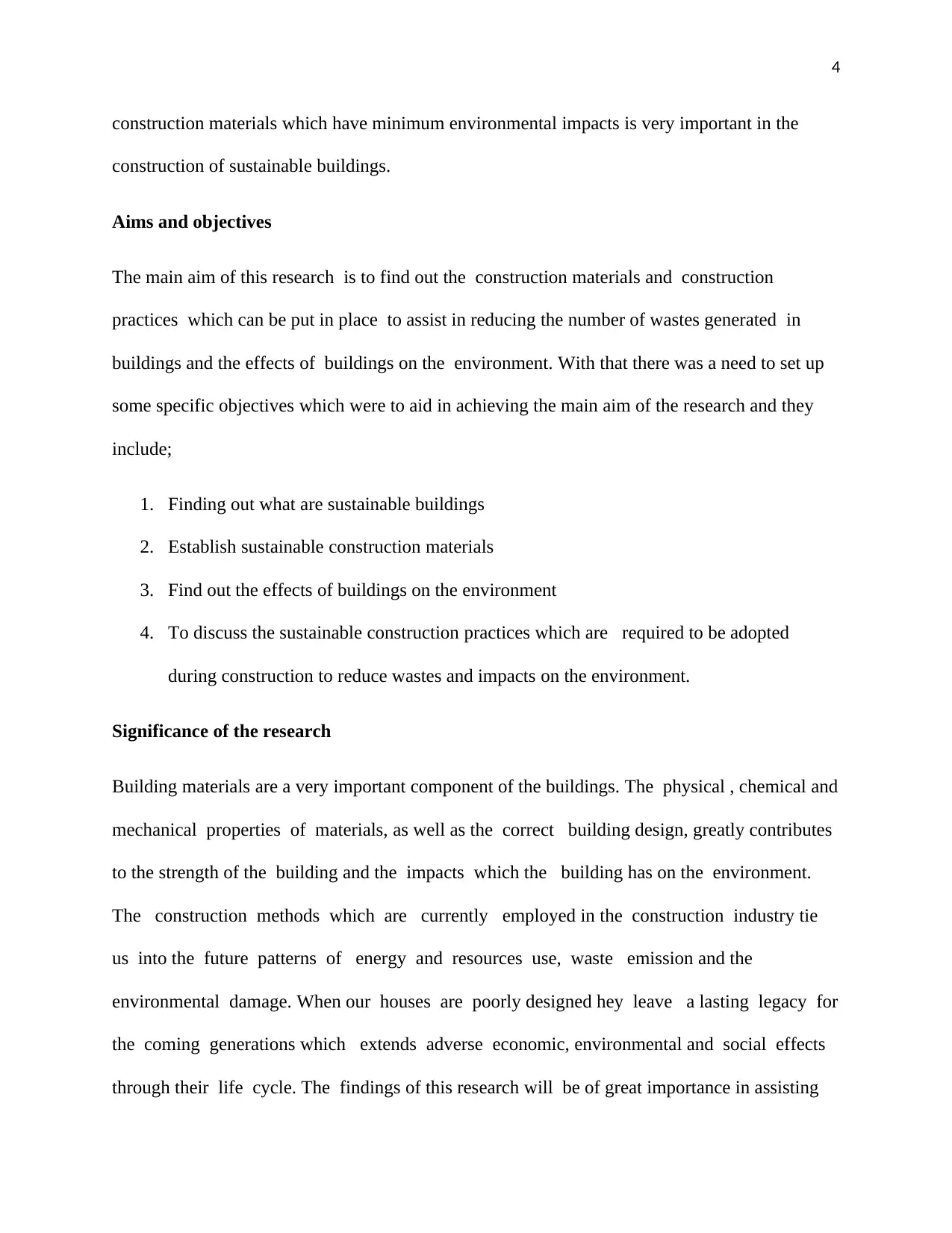
4
construction materials which have minimum environmental impacts is very important in the
construction of sustainable buildings.
Aims and objectives
The main aim of this research is to find out the construction materials and construction
practices which can be put in place to assist in reducing the number of wastes generated in
buildings and the effects of buildings on the environment. With that there was a need to set up
some specific objectives which were to aid in achieving the main aim of the research and they
include;
1. Finding out what are sustainable buildings
2. Establish sustainable construction materials
3. Find out the effects of buildings on the environment
4. To discuss the sustainable construction practices which are required to be adopted
during construction to reduce wastes and impacts on the environment.
Significance of the research
Building materials are a very important component of the buildings. The physical , chemical and
mechanical properties of materials, as well as the correct building design, greatly contributes
to the strength of the building and the impacts which the building has on the environment.
The construction methods which are currently employed in the construction industry tie
us into the future patterns of energy and resources use, waste emission and the
environmental damage. When our houses are poorly designed hey leave a lasting legacy for
the coming generations which extends adverse economic, environmental and social effects
through their life cycle. The findings of this research will be of great importance in assisting
construction materials which have minimum environmental impacts is very important in the
construction of sustainable buildings.
Aims and objectives
The main aim of this research is to find out the construction materials and construction
practices which can be put in place to assist in reducing the number of wastes generated in
buildings and the effects of buildings on the environment. With that there was a need to set up
some specific objectives which were to aid in achieving the main aim of the research and they
include;
1. Finding out what are sustainable buildings
2. Establish sustainable construction materials
3. Find out the effects of buildings on the environment
4. To discuss the sustainable construction practices which are required to be adopted
during construction to reduce wastes and impacts on the environment.
Significance of the research
Building materials are a very important component of the buildings. The physical , chemical and
mechanical properties of materials, as well as the correct building design, greatly contributes
to the strength of the building and the impacts which the building has on the environment.
The construction methods which are currently employed in the construction industry tie
us into the future patterns of energy and resources use, waste emission and the
environmental damage. When our houses are poorly designed hey leave a lasting legacy for
the coming generations which extends adverse economic, environmental and social effects
through their life cycle. The findings of this research will be of great importance in assisting
Paraphrase This Document
Need a fresh take? Get an instant paraphrase of this document with our AI Paraphraser

5
different parties in the construction industry to select the appropriate material which can assist
in the reduction of waters and impacts which the buildings have on the environment.
LITERATURE REVIEW
Sustainable building techniques
In the current world and state, there comes a need and requirement that the used building
techniques aimed towards conserving the environment and reduction in waste too. This is so for
efficiency in design, be able to avoid wastage of materials for future use and ensure a profit
realization out of it, and also to ensure that after the application of a particular technique, the
environment remains safe and conserved. They include
1. Construction waste management technique.
This technique comes along will a call to responsibility, where everyone has to take up their
primary and apt role to ensure that the management of waste is done to the latter and that the
environment is conserved alongside too. The application of the triple Rs can achieve the
technique; i.e., reducing, recycling, and reusing of waste materials. Thus ensuring that the
materials that would have been waste are used for doing something else; is recycled and thus
transformed into other forms to perform a different function and therefore the environment is
kept clean from the dumping of such waste (Braganca, 2016, p. 983).
This can be done through the creation of laws that would govern the practice of waste
management. The government can enact strict rules that would help in the conservation. In
Kenya, the government came up with a law that banned the use of plastic bags because when
dumped they do not decompose thus pollute the soil; they also cause suffocation to small
children who may not be in a position to know the risk while playing with them, and also affect
different parties in the construction industry to select the appropriate material which can assist
in the reduction of waters and impacts which the buildings have on the environment.
LITERATURE REVIEW
Sustainable building techniques
In the current world and state, there comes a need and requirement that the used building
techniques aimed towards conserving the environment and reduction in waste too. This is so for
efficiency in design, be able to avoid wastage of materials for future use and ensure a profit
realization out of it, and also to ensure that after the application of a particular technique, the
environment remains safe and conserved. They include
1. Construction waste management technique.
This technique comes along will a call to responsibility, where everyone has to take up their
primary and apt role to ensure that the management of waste is done to the latter and that the
environment is conserved alongside too. The application of the triple Rs can achieve the
technique; i.e., reducing, recycling, and reusing of waste materials. Thus ensuring that the
materials that would have been waste are used for doing something else; is recycled and thus
transformed into other forms to perform a different function and therefore the environment is
kept clean from the dumping of such waste (Braganca, 2016, p. 983).
This can be done through the creation of laws that would govern the practice of waste
management. The government can enact strict rules that would help in the conservation. In
Kenya, the government came up with a law that banned the use of plastic bags because when
dumped they do not decompose thus pollute the soil; they also cause suffocation to small
children who may not be in a position to know the risk while playing with them, and also affect
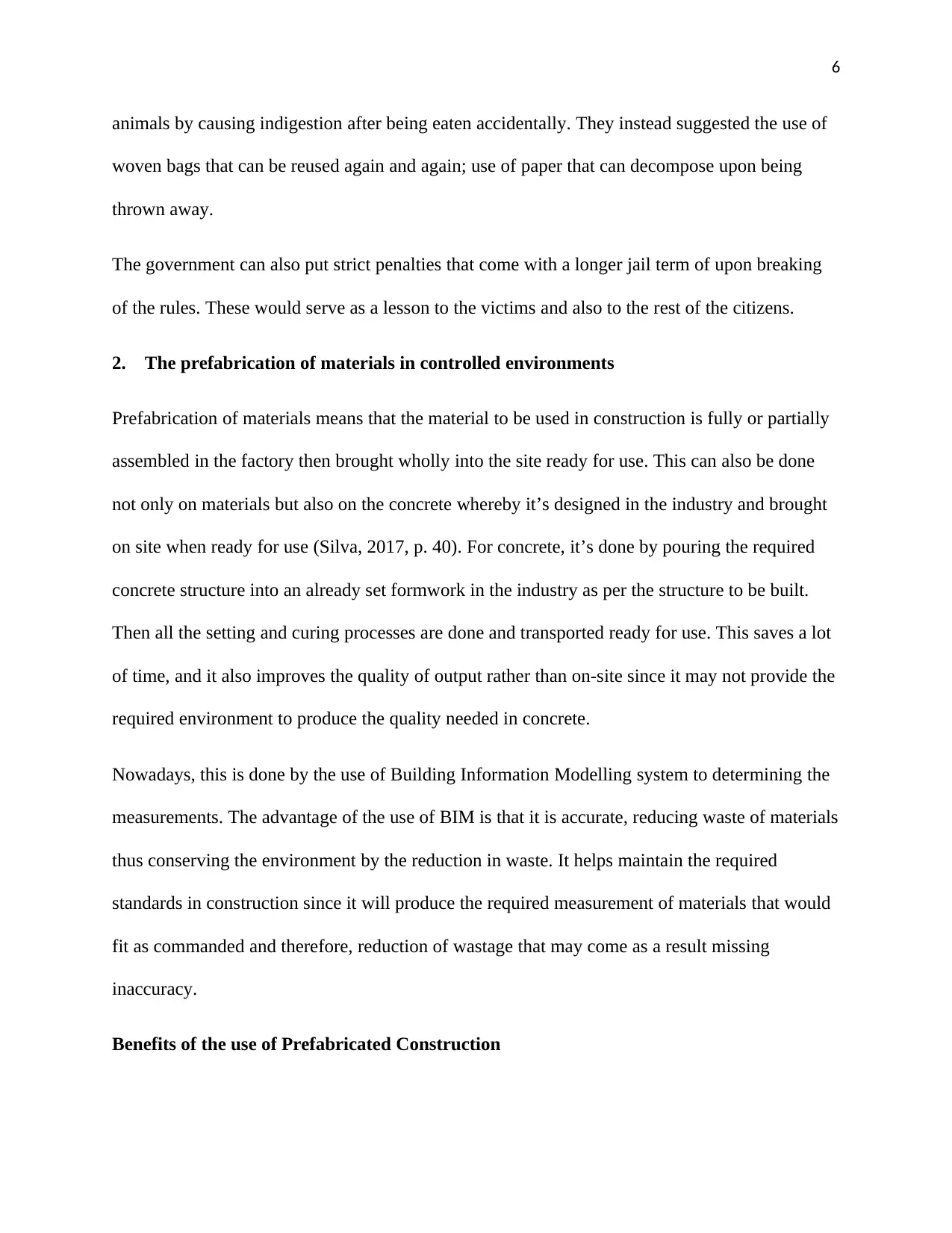
6
animals by causing indigestion after being eaten accidentally. They instead suggested the use of
woven bags that can be reused again and again; use of paper that can decompose upon being
thrown away.
The government can also put strict penalties that come with a longer jail term of upon breaking
of the rules. These would serve as a lesson to the victims and also to the rest of the citizens.
2. The prefabrication of materials in controlled environments
Prefabrication of materials means that the material to be used in construction is fully or partially
assembled in the factory then brought wholly into the site ready for use. This can also be done
not only on materials but also on the concrete whereby it’s designed in the industry and brought
on site when ready for use (Silva, 2017, p. 40). For concrete, it’s done by pouring the required
concrete structure into an already set formwork in the industry as per the structure to be built.
Then all the setting and curing processes are done and transported ready for use. This saves a lot
of time, and it also improves the quality of output rather than on-site since it may not provide the
required environment to produce the quality needed in concrete.
Nowadays, this is done by the use of Building Information Modelling system to determining the
measurements. The advantage of the use of BIM is that it is accurate, reducing waste of materials
thus conserving the environment by the reduction in waste. It helps maintain the required
standards in construction since it will produce the required measurement of materials that would
fit as commanded and therefore, reduction of wastage that may come as a result missing
inaccuracy.
Benefits of the use of Prefabricated Construction
animals by causing indigestion after being eaten accidentally. They instead suggested the use of
woven bags that can be reused again and again; use of paper that can decompose upon being
thrown away.
The government can also put strict penalties that come with a longer jail term of upon breaking
of the rules. These would serve as a lesson to the victims and also to the rest of the citizens.
2. The prefabrication of materials in controlled environments
Prefabrication of materials means that the material to be used in construction is fully or partially
assembled in the factory then brought wholly into the site ready for use. This can also be done
not only on materials but also on the concrete whereby it’s designed in the industry and brought
on site when ready for use (Silva, 2017, p. 40). For concrete, it’s done by pouring the required
concrete structure into an already set formwork in the industry as per the structure to be built.
Then all the setting and curing processes are done and transported ready for use. This saves a lot
of time, and it also improves the quality of output rather than on-site since it may not provide the
required environment to produce the quality needed in concrete.
Nowadays, this is done by the use of Building Information Modelling system to determining the
measurements. The advantage of the use of BIM is that it is accurate, reducing waste of materials
thus conserving the environment by the reduction in waste. It helps maintain the required
standards in construction since it will produce the required measurement of materials that would
fit as commanded and therefore, reduction of wastage that may come as a result missing
inaccuracy.
Benefits of the use of Prefabricated Construction
⊘ This is a preview!⊘
Do you want full access?
Subscribe today to unlock all pages.

Trusted by 1+ million students worldwide
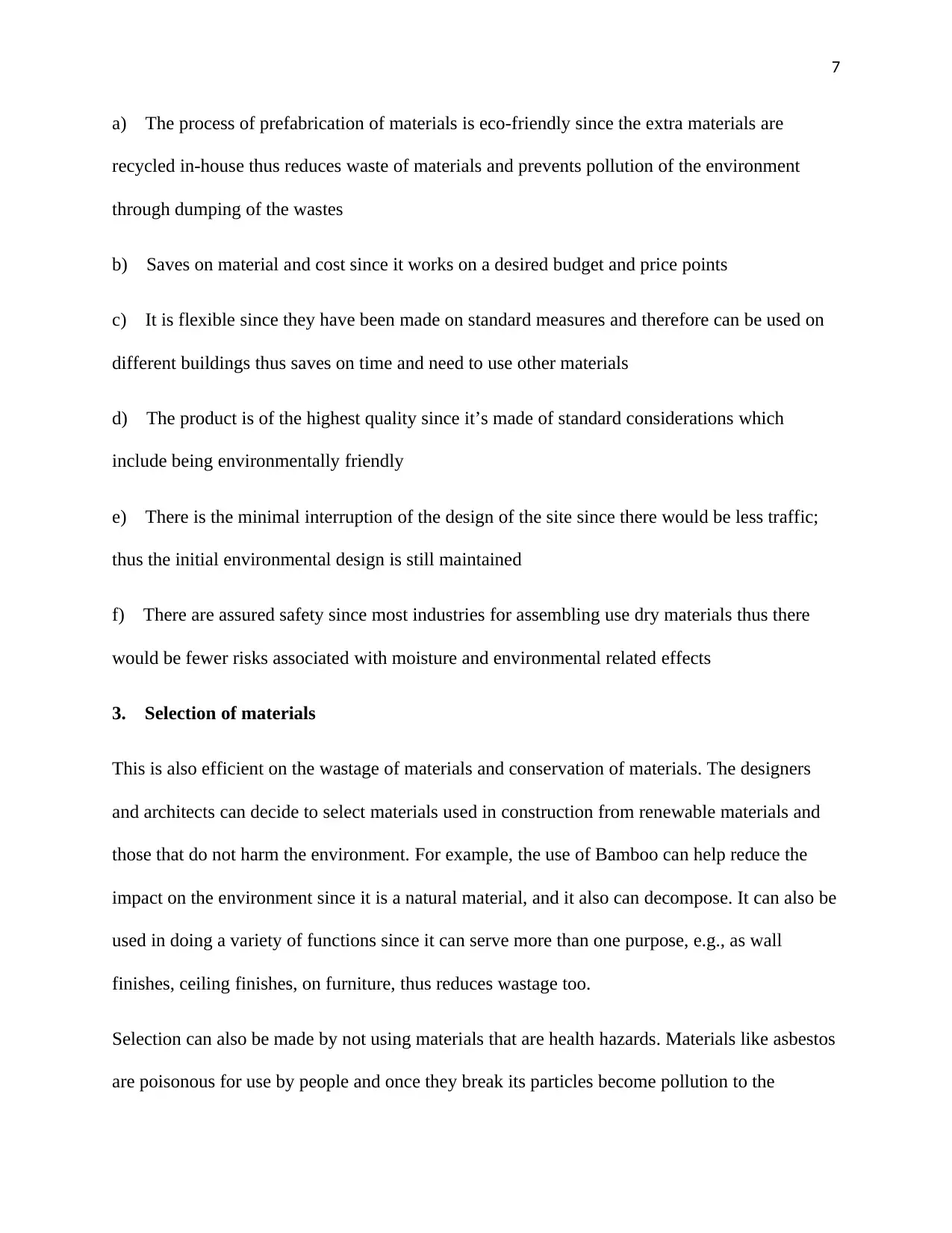
7
a) The process of prefabrication of materials is eco-friendly since the extra materials are
recycled in-house thus reduces waste of materials and prevents pollution of the environment
through dumping of the wastes
b) Saves on material and cost since it works on a desired budget and price points
c) It is flexible since they have been made on standard measures and therefore can be used on
different buildings thus saves on time and need to use other materials
d) The product is of the highest quality since it’s made of standard considerations which
include being environmentally friendly
e) There is the minimal interruption of the design of the site since there would be less traffic;
thus the initial environmental design is still maintained
f) There are assured safety since most industries for assembling use dry materials thus there
would be fewer risks associated with moisture and environmental related effects
3. Selection of materials
This is also efficient on the wastage of materials and conservation of materials. The designers
and architects can decide to select materials used in construction from renewable materials and
those that do not harm the environment. For example, the use of Bamboo can help reduce the
impact on the environment since it is a natural material, and it also can decompose. It can also be
used in doing a variety of functions since it can serve more than one purpose, e.g., as wall
finishes, ceiling finishes, on furniture, thus reduces wastage too.
Selection can also be made by not using materials that are health hazards. Materials like asbestos
are poisonous for use by people and once they break its particles become pollution to the
a) The process of prefabrication of materials is eco-friendly since the extra materials are
recycled in-house thus reduces waste of materials and prevents pollution of the environment
through dumping of the wastes
b) Saves on material and cost since it works on a desired budget and price points
c) It is flexible since they have been made on standard measures and therefore can be used on
different buildings thus saves on time and need to use other materials
d) The product is of the highest quality since it’s made of standard considerations which
include being environmentally friendly
e) There is the minimal interruption of the design of the site since there would be less traffic;
thus the initial environmental design is still maintained
f) There are assured safety since most industries for assembling use dry materials thus there
would be fewer risks associated with moisture and environmental related effects
3. Selection of materials
This is also efficient on the wastage of materials and conservation of materials. The designers
and architects can decide to select materials used in construction from renewable materials and
those that do not harm the environment. For example, the use of Bamboo can help reduce the
impact on the environment since it is a natural material, and it also can decompose. It can also be
used in doing a variety of functions since it can serve more than one purpose, e.g., as wall
finishes, ceiling finishes, on furniture, thus reduces wastage too.
Selection can also be made by not using materials that are health hazards. Materials like asbestos
are poisonous for use by people and once they break its particles become pollution to the
Paraphrase This Document
Need a fresh take? Get an instant paraphrase of this document with our AI Paraphraser
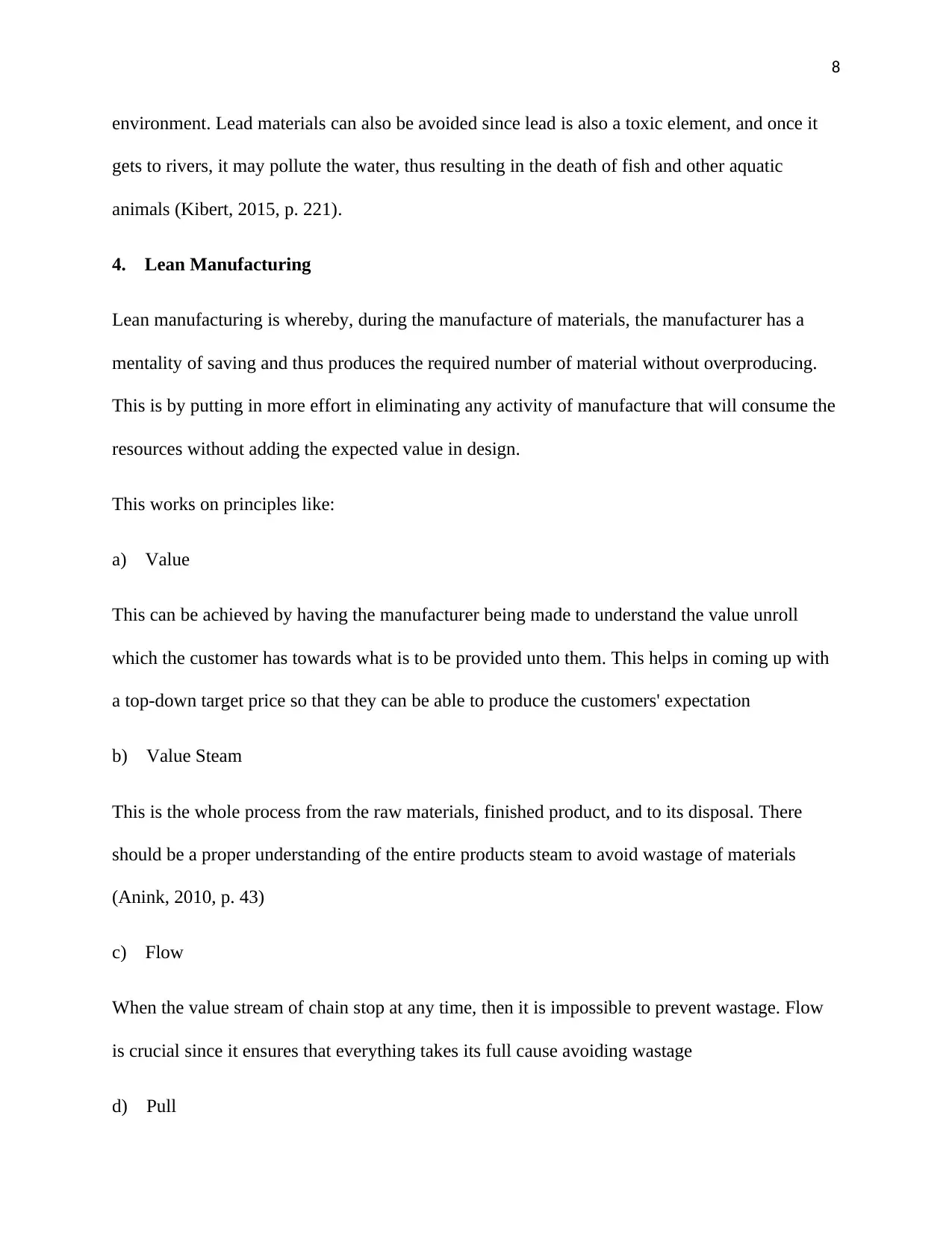
8
environment. Lead materials can also be avoided since lead is also a toxic element, and once it
gets to rivers, it may pollute the water, thus resulting in the death of fish and other aquatic
animals (Kibert, 2015, p. 221).
4. Lean Manufacturing
Lean manufacturing is whereby, during the manufacture of materials, the manufacturer has a
mentality of saving and thus produces the required number of material without overproducing.
This is by putting in more effort in eliminating any activity of manufacture that will consume the
resources without adding the expected value in design.
This works on principles like:
a) Value
This can be achieved by having the manufacturer being made to understand the value unroll
which the customer has towards what is to be provided unto them. This helps in coming up with
a top-down target price so that they can be able to produce the customers' expectation
b) Value Steam
This is the whole process from the raw materials, finished product, and to its disposal. There
should be a proper understanding of the entire products steam to avoid wastage of materials
(Anink, 2010, p. 43)
c) Flow
When the value stream of chain stop at any time, then it is impossible to prevent wastage. Flow
is crucial since it ensures that everything takes its full cause avoiding wastage
d) Pull
environment. Lead materials can also be avoided since lead is also a toxic element, and once it
gets to rivers, it may pollute the water, thus resulting in the death of fish and other aquatic
animals (Kibert, 2015, p. 221).
4. Lean Manufacturing
Lean manufacturing is whereby, during the manufacture of materials, the manufacturer has a
mentality of saving and thus produces the required number of material without overproducing.
This is by putting in more effort in eliminating any activity of manufacture that will consume the
resources without adding the expected value in design.
This works on principles like:
a) Value
This can be achieved by having the manufacturer being made to understand the value unroll
which the customer has towards what is to be provided unto them. This helps in coming up with
a top-down target price so that they can be able to produce the customers' expectation
b) Value Steam
This is the whole process from the raw materials, finished product, and to its disposal. There
should be a proper understanding of the entire products steam to avoid wastage of materials
(Anink, 2010, p. 43)
c) Flow
When the value stream of chain stop at any time, then it is impossible to prevent wastage. Flow
is crucial since it ensures that everything takes its full cause avoiding wastage
d) Pull
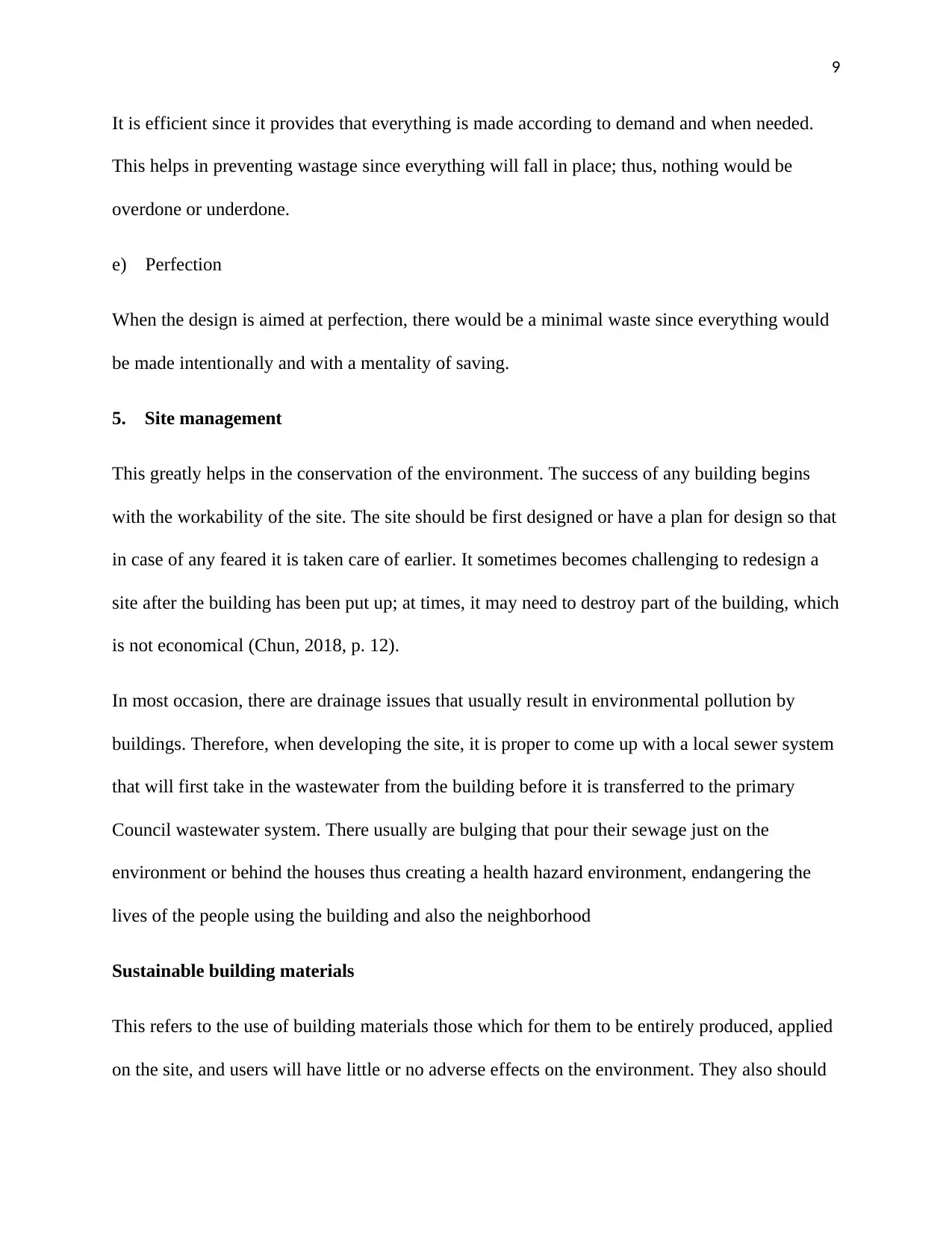
9
It is efficient since it provides that everything is made according to demand and when needed.
This helps in preventing wastage since everything will fall in place; thus, nothing would be
overdone or underdone.
e) Perfection
When the design is aimed at perfection, there would be a minimal waste since everything would
be made intentionally and with a mentality of saving.
5. Site management
This greatly helps in the conservation of the environment. The success of any building begins
with the workability of the site. The site should be first designed or have a plan for design so that
in case of any feared it is taken care of earlier. It sometimes becomes challenging to redesign a
site after the building has been put up; at times, it may need to destroy part of the building, which
is not economical (Chun, 2018, p. 12).
In most occasion, there are drainage issues that usually result in environmental pollution by
buildings. Therefore, when developing the site, it is proper to come up with a local sewer system
that will first take in the wastewater from the building before it is transferred to the primary
Council wastewater system. There usually are bulging that pour their sewage just on the
environment or behind the houses thus creating a health hazard environment, endangering the
lives of the people using the building and also the neighborhood
Sustainable building materials
This refers to the use of building materials those which for them to be entirely produced, applied
on the site, and users will have little or no adverse effects on the environment. They also should
It is efficient since it provides that everything is made according to demand and when needed.
This helps in preventing wastage since everything will fall in place; thus, nothing would be
overdone or underdone.
e) Perfection
When the design is aimed at perfection, there would be a minimal waste since everything would
be made intentionally and with a mentality of saving.
5. Site management
This greatly helps in the conservation of the environment. The success of any building begins
with the workability of the site. The site should be first designed or have a plan for design so that
in case of any feared it is taken care of earlier. It sometimes becomes challenging to redesign a
site after the building has been put up; at times, it may need to destroy part of the building, which
is not economical (Chun, 2018, p. 12).
In most occasion, there are drainage issues that usually result in environmental pollution by
buildings. Therefore, when developing the site, it is proper to come up with a local sewer system
that will first take in the wastewater from the building before it is transferred to the primary
Council wastewater system. There usually are bulging that pour their sewage just on the
environment or behind the houses thus creating a health hazard environment, endangering the
lives of the people using the building and also the neighborhood
Sustainable building materials
This refers to the use of building materials those which for them to be entirely produced, applied
on the site, and users will have little or no adverse effects on the environment. They also should
⊘ This is a preview!⊘
Do you want full access?
Subscribe today to unlock all pages.

Trusted by 1+ million students worldwide
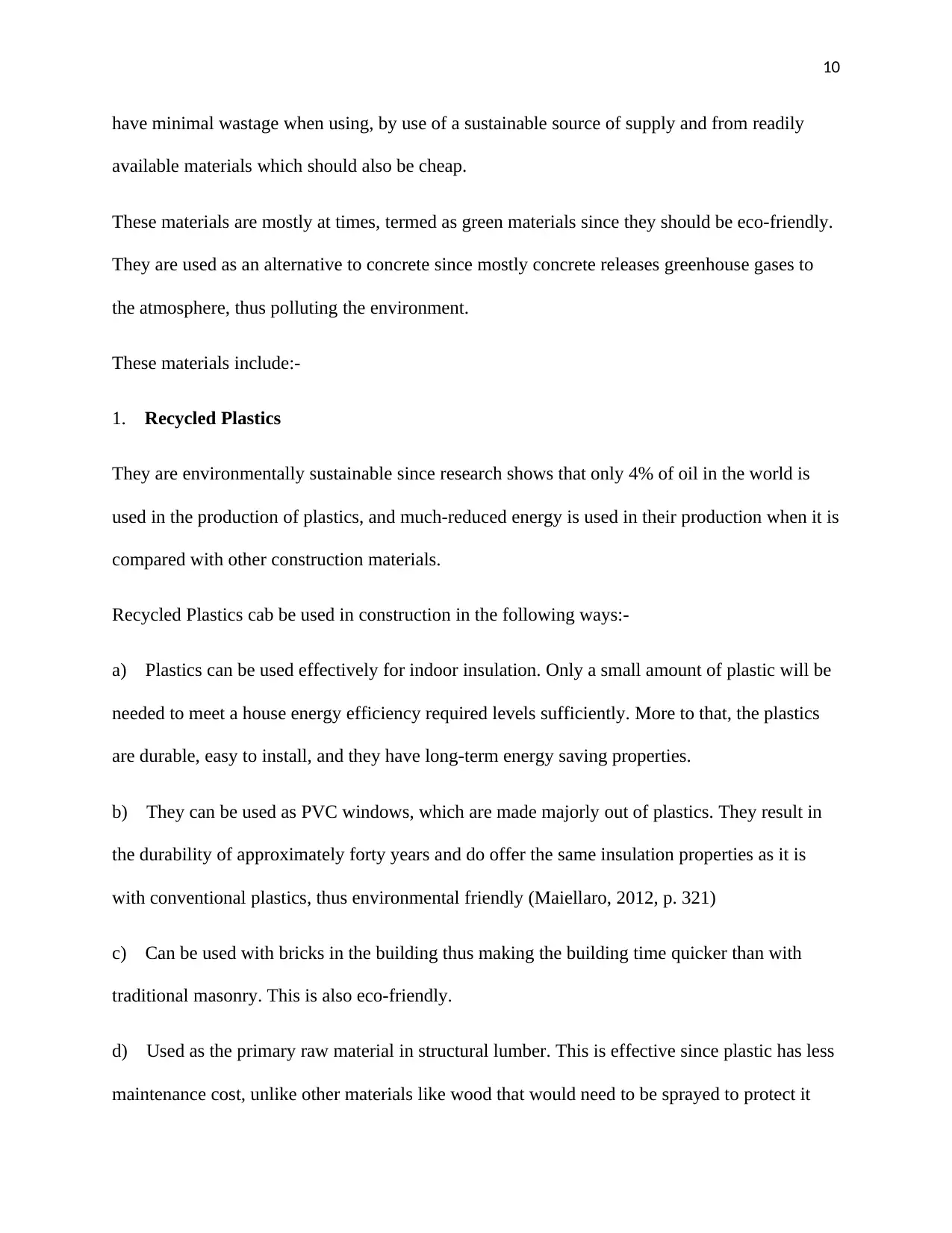
10
have minimal wastage when using, by use of a sustainable source of supply and from readily
available materials which should also be cheap.
These materials are mostly at times, termed as green materials since they should be eco-friendly.
They are used as an alternative to concrete since mostly concrete releases greenhouse gases to
the atmosphere, thus polluting the environment.
These materials include:-
1. Recycled Plastics
They are environmentally sustainable since research shows that only 4% of oil in the world is
used in the production of plastics, and much-reduced energy is used in their production when it is
compared with other construction materials.
Recycled Plastics cab be used in construction in the following ways:-
a) Plastics can be used effectively for indoor insulation. Only a small amount of plastic will be
needed to meet a house energy efficiency required levels sufficiently. More to that, the plastics
are durable, easy to install, and they have long-term energy saving properties.
b) They can be used as PVC windows, which are made majorly out of plastics. They result in
the durability of approximately forty years and do offer the same insulation properties as it is
with conventional plastics, thus environmental friendly (Maiellaro, 2012, p. 321)
c) Can be used with bricks in the building thus making the building time quicker than with
traditional masonry. This is also eco-friendly.
d) Used as the primary raw material in structural lumber. This is effective since plastic has less
maintenance cost, unlike other materials like wood that would need to be sprayed to protect it
have minimal wastage when using, by use of a sustainable source of supply and from readily
available materials which should also be cheap.
These materials are mostly at times, termed as green materials since they should be eco-friendly.
They are used as an alternative to concrete since mostly concrete releases greenhouse gases to
the atmosphere, thus polluting the environment.
These materials include:-
1. Recycled Plastics
They are environmentally sustainable since research shows that only 4% of oil in the world is
used in the production of plastics, and much-reduced energy is used in their production when it is
compared with other construction materials.
Recycled Plastics cab be used in construction in the following ways:-
a) Plastics can be used effectively for indoor insulation. Only a small amount of plastic will be
needed to meet a house energy efficiency required levels sufficiently. More to that, the plastics
are durable, easy to install, and they have long-term energy saving properties.
b) They can be used as PVC windows, which are made majorly out of plastics. They result in
the durability of approximately forty years and do offer the same insulation properties as it is
with conventional plastics, thus environmental friendly (Maiellaro, 2012, p. 321)
c) Can be used with bricks in the building thus making the building time quicker than with
traditional masonry. This is also eco-friendly.
d) Used as the primary raw material in structural lumber. This is effective since plastic has less
maintenance cost, unlike other materials like wood that would need to be sprayed to protect it
Paraphrase This Document
Need a fresh take? Get an instant paraphrase of this document with our AI Paraphraser

11
from insects and weather too. These sprays at times pollute the air, and therefore, the use of
plastics prevents such pollution from occurring.
2. Straw Bales
This is the use of bales of straw, which may include rice, wheat and oats straw, as the structural
elements, the insulation of buildings or both.
Sustainable qualities
1. Successful in sound insulation; thus, when used in a noisy room it prevents noise pollution
the environment.
2. When successfully installed the insulate heat; thus if used in cold areas it will help keep the
place hot for the people using it hence environmental friendly.
3. It thermally insulates a building and therefore reducing temperature swings during the day
thus conservancy of the environment within and without the building
4. Pest-resistant and thus, the building is free from the use of pesticides that pollute the air.
3. Bamboo
It has mostly been used as a traditional building material, and it has of recent been known
because of its functional properties in environmental sustainability. This is so because bamboo
grows faster and it requires no fertilizers, unlike other types of crops. It also has a wide variety of
uses, from small things to big ones. It regenerates its roots; therefore, it does not need to be
replanted, it will continue growing even after the first harvest (Calkins, 2016, p. 592).
Sustainable qualities of bamboo
from insects and weather too. These sprays at times pollute the air, and therefore, the use of
plastics prevents such pollution from occurring.
2. Straw Bales
This is the use of bales of straw, which may include rice, wheat and oats straw, as the structural
elements, the insulation of buildings or both.
Sustainable qualities
1. Successful in sound insulation; thus, when used in a noisy room it prevents noise pollution
the environment.
2. When successfully installed the insulate heat; thus if used in cold areas it will help keep the
place hot for the people using it hence environmental friendly.
3. It thermally insulates a building and therefore reducing temperature swings during the day
thus conservancy of the environment within and without the building
4. Pest-resistant and thus, the building is free from the use of pesticides that pollute the air.
3. Bamboo
It has mostly been used as a traditional building material, and it has of recent been known
because of its functional properties in environmental sustainability. This is so because bamboo
grows faster and it requires no fertilizers, unlike other types of crops. It also has a wide variety of
uses, from small things to big ones. It regenerates its roots; therefore, it does not need to be
replanted, it will continue growing even after the first harvest (Calkins, 2016, p. 592).
Sustainable qualities of bamboo
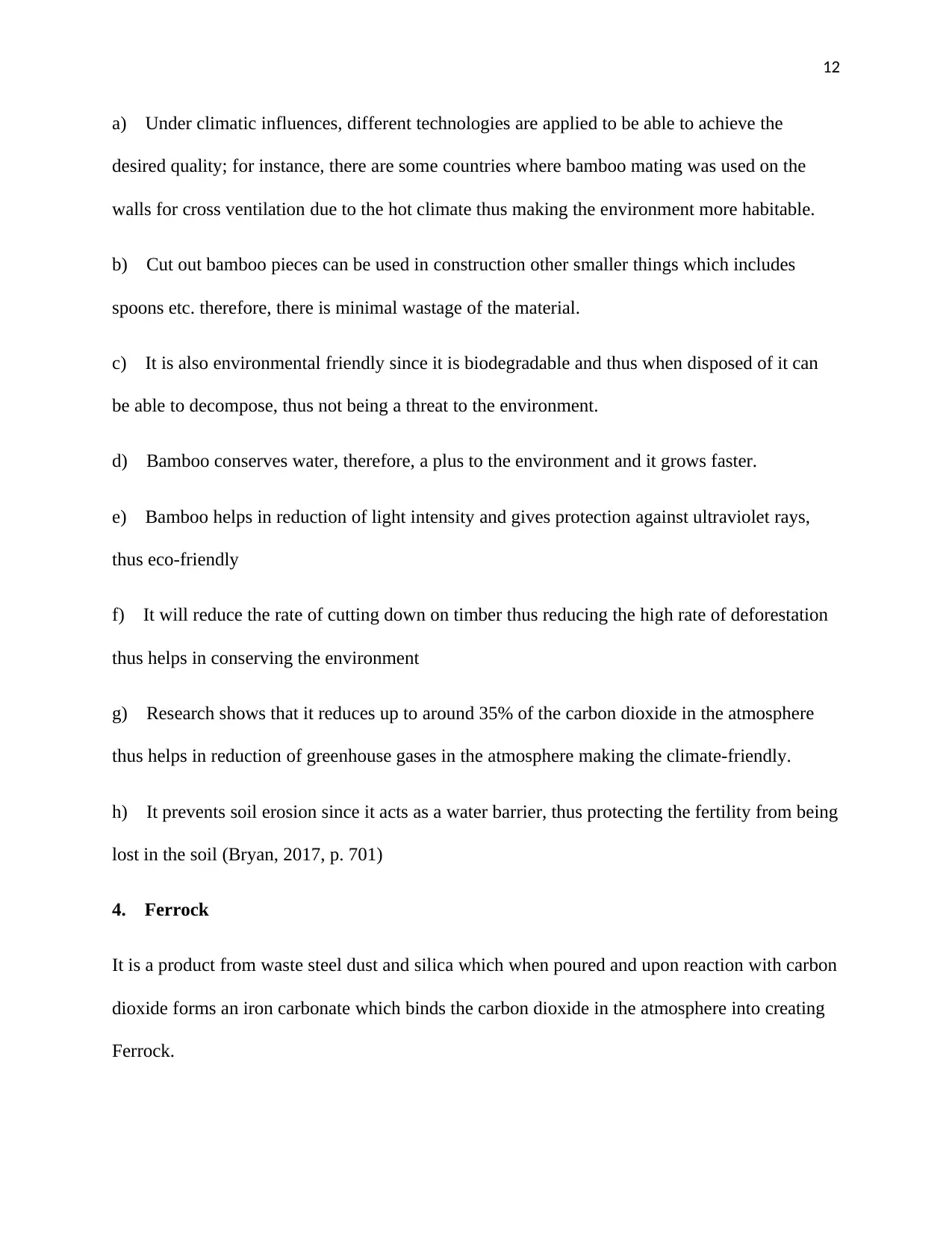
12
a) Under climatic influences, different technologies are applied to be able to achieve the
desired quality; for instance, there are some countries where bamboo mating was used on the
walls for cross ventilation due to the hot climate thus making the environment more habitable.
b) Cut out bamboo pieces can be used in construction other smaller things which includes
spoons etc. therefore, there is minimal wastage of the material.
c) It is also environmental friendly since it is biodegradable and thus when disposed of it can
be able to decompose, thus not being a threat to the environment.
d) Bamboo conserves water, therefore, a plus to the environment and it grows faster.
e) Bamboo helps in reduction of light intensity and gives protection against ultraviolet rays,
thus eco-friendly
f) It will reduce the rate of cutting down on timber thus reducing the high rate of deforestation
thus helps in conserving the environment
g) Research shows that it reduces up to around 35% of the carbon dioxide in the atmosphere
thus helps in reduction of greenhouse gases in the atmosphere making the climate-friendly.
h) It prevents soil erosion since it acts as a water barrier, thus protecting the fertility from being
lost in the soil (Bryan, 2017, p. 701)
4. Ferrock
It is a product from waste steel dust and silica which when poured and upon reaction with carbon
dioxide forms an iron carbonate which binds the carbon dioxide in the atmosphere into creating
Ferrock.
a) Under climatic influences, different technologies are applied to be able to achieve the
desired quality; for instance, there are some countries where bamboo mating was used on the
walls for cross ventilation due to the hot climate thus making the environment more habitable.
b) Cut out bamboo pieces can be used in construction other smaller things which includes
spoons etc. therefore, there is minimal wastage of the material.
c) It is also environmental friendly since it is biodegradable and thus when disposed of it can
be able to decompose, thus not being a threat to the environment.
d) Bamboo conserves water, therefore, a plus to the environment and it grows faster.
e) Bamboo helps in reduction of light intensity and gives protection against ultraviolet rays,
thus eco-friendly
f) It will reduce the rate of cutting down on timber thus reducing the high rate of deforestation
thus helps in conserving the environment
g) Research shows that it reduces up to around 35% of the carbon dioxide in the atmosphere
thus helps in reduction of greenhouse gases in the atmosphere making the climate-friendly.
h) It prevents soil erosion since it acts as a water barrier, thus protecting the fertility from being
lost in the soil (Bryan, 2017, p. 701)
4. Ferrock
It is a product from waste steel dust and silica which when poured and upon reaction with carbon
dioxide forms an iron carbonate which binds the carbon dioxide in the atmosphere into creating
Ferrock.
⊘ This is a preview!⊘
Do you want full access?
Subscribe today to unlock all pages.

Trusted by 1+ million students worldwide
1 out of 24
Related Documents
Your All-in-One AI-Powered Toolkit for Academic Success.
+13062052269
info@desklib.com
Available 24*7 on WhatsApp / Email
![[object Object]](/_next/static/media/star-bottom.7253800d.svg)
Unlock your academic potential
Copyright © 2020–2025 A2Z Services. All Rights Reserved. Developed and managed by ZUCOL.




